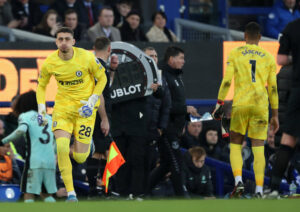Welcome to Last Word on Football’s ‘Returning Players’ series. In this edition, we take a look at Sol Campbell.
Campbell turned out for Arsenal 197 times in his first spell at the club, after making the scarcely believable move from Tottenham Hotspur on a free transfer in 2001. Having left the Gunners in 2006, he went on to win the FA Cup with Portsmouth before a bizarre switch to Notts County in League Two.
Training with Arsenal in the winter of the 2009/10 season whilst a free agent, he put pen to paper on a shock deal to join them until the end of that campaign.
Returning Players – Sol Campbell
First Spell at Arsenal
The story goes that the national press were present at Arsenal’s training ground to cover the signing of Richard Wright. But there was confusion in the air. The transfer of a back-up goalkeeper was small time for a club of their stature.
Out of nowhere, à la Randy Orton, Sol Campbell was unveiled as an Arsenal player, mere months after he went on record saying he could never play for them.
In a bitter rivalry that needed little excuse to be re-ignited, Campbell’s hop across north London didn’t so much stoke the fire as lather it with napalm. On reflection, deciding to swap one end of the W3 bus route for the other was an unprecedented risk, but one that most certainly paid off for the defender.
His first full season at Highbury saw him win the double under Arsène Wenger, with Campbell’s daunting presence at centre-half an instrumental factor in that side’s successes. After his last appearance in a Spurs shirt came in an FA Cup semi-final loss to his new employers, it seemed like poetic justice that he claimed the trophy with Arsenal after putting his neck, hell, his entire reputation, on the line.
That would not be the height of his time at Highbury, not even close. His zenith as a Gunner came two seasons later as part of the ‘Invincibles’ who, led by Campbell’s commandeering qualities at the back, conceding just 26 goals in 38 league matches. That’s an average of just 0.68 per game.
A fallout with Wenger in 2004/05 saw Campbell dismayed at being benched for a young Philippe Senderos. This marked the start of a downward spiral for the former.
Campbell struggled with numerous injuries as well as a loss of form in Arsenal’s last term at Highbury and, despite heading the Gunners to the cusp of Champions League glory, 12 fateful minutes in Paris had made up his mind: a change of scene would suit all parties involved.
Teams Campbell Played for in Between
By the time his first Arsenal spell ended, Campbell’s qualities were well known. 31 at the time and not far past his prime, he had suitors over Europe, including Juventus and Fenerbahçe. As a result, it was somewhat surprising that he elected to join Harry Redknapp on the south coast and sign for Portsmouth.
A promising first season at Pompey saw them finish in the top half and Campbell entrusted with the captaincy for the 2007/08 campaign. A respectable position of eighth-place in the league, including that 7-4 win against Reading, saw Portsmouth qualify for the UEFA Cup. However, it was in a domestic cup where they made all the headlines.
Beating Manchester United en route to the final, Campbell led the Hampshire outfit to only their second ever FA Cup when another ex-Arsenal man, Kanu, scored the winner against Cardiff City at Wembley.
A fairytale result it may have been, yet Portsmouth’s pursuit of silverware had left them in dire financial straits. Campbell helped his team avoid relegation to the Championship but, when Redknapp resigned, the writing was on the wall. If the veteran captain’s departure from Fratton Park was predictable given the circumstances, his next destination was entirely unforeseeable.
For a seasoned England international to appear in the Coca-Cola League Two just a year after lifting the greatest cup in English football, is almost unfathomable. Remarkably, it became a reality when Campbell agreed to join Notts County.
But for all the hype his move to the Midlands created, Campbell caused even more controversy by walking out on the Magpies just three days after he arrived in Nottingham. Labelling himself as a “mug” in his biography, it’s safe to say this transfer is one of the freakiest in football history.
Return to Arsenal
Now a free agent, Campbell was invited to train with Arsenal at London Colney by Wenger in a bid to maintain his fitness.
Thinking he would be able to find himself another contract, he didn’t have to look very far when Arsenal were blighted by an injury crisis as January arrived.
Awarded the No.31 shirt, Campbell’s return to Arsenal was complete. His second debut came in an FA Cup loss to Stoke City, where Arsenal experienced their customary bullying at the hands of Ryan Shawcross, Rory Delap and co.
A Champions League tie at Porto marked his 200th appearance in red and white and the centre-back celebrated the occasion with a bullet header to level the match at 1-1. However, thanks to a clanger of a display from Lukasz Fabianski, Arsenal went down 2-1.
Unexpectedly, the Englishman’s playing time was frequent throughout the rest of the 2009/10 season, due to injuries suffered by Thomas Vermaelen and William Gallas. Considering the circumstances, he performed rather well, although a geriatric pairing of Campbell and Mikael Silvestre was never going to be a firm foundation for success. Several solid showings did enough to convince Alan Pardew to sign Campbell on a one-year deal at Newcastle United before the central defender hung up his boots in 2011.
Sol Campbell’s return to Arsenal was not as romantic as that of former team-mate Thierry Henry, but Arsenal fans were nonetheless appreciative of his services in a time where he was desperately needed. Campbell remained at 35, as he had been throughout his career, an ever-willing warrior that could not turn down one last chance of a brutal battle.
Main Photo






